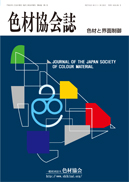All issues

Predecessor
Volume 86, Issue 4
Displaying 1-5 of 5 articles from this issue
- |<
- <
- 1
- >
- >|
Original Research Paper
-
−Proportionality between Storage Modulus and Crosslink Density−Kanji MORI2013 Volume 86 Issue 4 Pages 123-127
Published: April 20, 2013
Released on J-STAGE: July 20, 2013
JOURNAL FREE ACCESSA viscoelasticity measurement device for measuring complex moduli of coatings films during cureing processes was applied to isothermal curing of a model system composed of acrylic polyol and isocyanate crosslinker. The change of elastic modulus of the coating film was correlated with degree of crosslink reaction estimated from IR analysis of the film. The elastic modulus of the coating film increased in a sigmoidal curve indicating curing is divided into two steps ; concave part of mixed process of network forming and chain extending reactions followed by convex part of purely network building process. Within the region of convex part, the rate of increase of elastic modulus was proportional to that of degree of crosslink reaction. This result means that elastic modulus of coatings films is proportional to crosslink density and the device is capable of monitoring changes of crosslink density of films in real time.View full abstractDownload PDF (976K)
Digest
-
Toshihiro ISOBE2013 Volume 86 Issue 4 Pages 128-132
Published: April 20, 2013
Released on J-STAGE: July 20, 2013
JOURNAL FREE ACCESSDispersion and agglomeration of colloids in a solvent is explained by Derjaguin-Landau-Vervey-Overbeek (DLVO) theory. However, surface forces that are not considered in the DVLO theory (non-DLVO force) have also been known. DLVO/non-DLVO interaction can be experimentally measured by using the surface force apparatus and the colloid probe method of the scanning probe microscopy. The interaction between an Al2O3 colloid and sapphire surface was investigated in an aqueous solution containing various ions using the colloidal probe method. The repulsive forces were observed at less 20 nm separation distance. This difference corresponded to the dispersibility of Al2O3 particles in the solvent. The behavior of the organic additives on the solid surface was estimated. The repulsive force and the extensions originating to the organic additives were observed. Moreover, the behaviour of the organic additives in the suspensions or slurries is affected by not only the properties of molecules but also by interaction with other additives.View full abstractDownload PDF (1506K)
Review
<Colour Material Renaissance>Film Forming Technology for the Colour Material Industry over the Past 85 Years
-
Masanori NAGAI2013 Volume 86 Issue 4 Pages 133-138
Published: April 20, 2013
Released on J-STAGE: July 20, 2013
JOURNAL FREE ACCESSIn general, coatings are used to provide anti-corrosive performance to metals. Long ago, the function of coatings was merely to provide color but this later expanded to also include protection and appearance.
In the current paper the history of anti-corrosive coatings in Japan is explained. Taking a zinc / epoxy resin / fluoropolymer coating system as an example, the durability evaluation results is presented from which it can be understood that the system has excellent weatherability and anti-corrosive properties.View full abstractDownload PDF (1467K)
Serial Lecture
-
Atsushi MIYAKI2013 Volume 86 Issue 4 Pages 139-144
Published: April 20, 2013
Released on J-STAGE: July 20, 2013
JOURNAL FREE ACCESSScanning electron microscopes (SEMs) are powerful tools for the observation of samples with high resolution and are widely used for various fields of studies. The recent improvement of design enables us to obtain the outermost information of sample with the deceleration technique. Here, we reviewed the principle and structures of SEM and some applications to the functional materials.View full abstractDownload PDF (1643K)
-
Masataka OZAKI2013 Volume 86 Issue 4 Pages 145-151
Published: April 20, 2013
Released on J-STAGE: July 20, 2013
JOURNAL FREE ACCESSVarious methods for the examination of dispersibilitity of colloidal dispersions are described. Observations of the dispersion by a reversed type optical microscope, measurements of viscosity, particle size and zeta potential are useful methods for the examination of the dispersibility of colloidal dispersions.View full abstractDownload PDF (1429K)
- |<
- <
- 1
- >
- >|